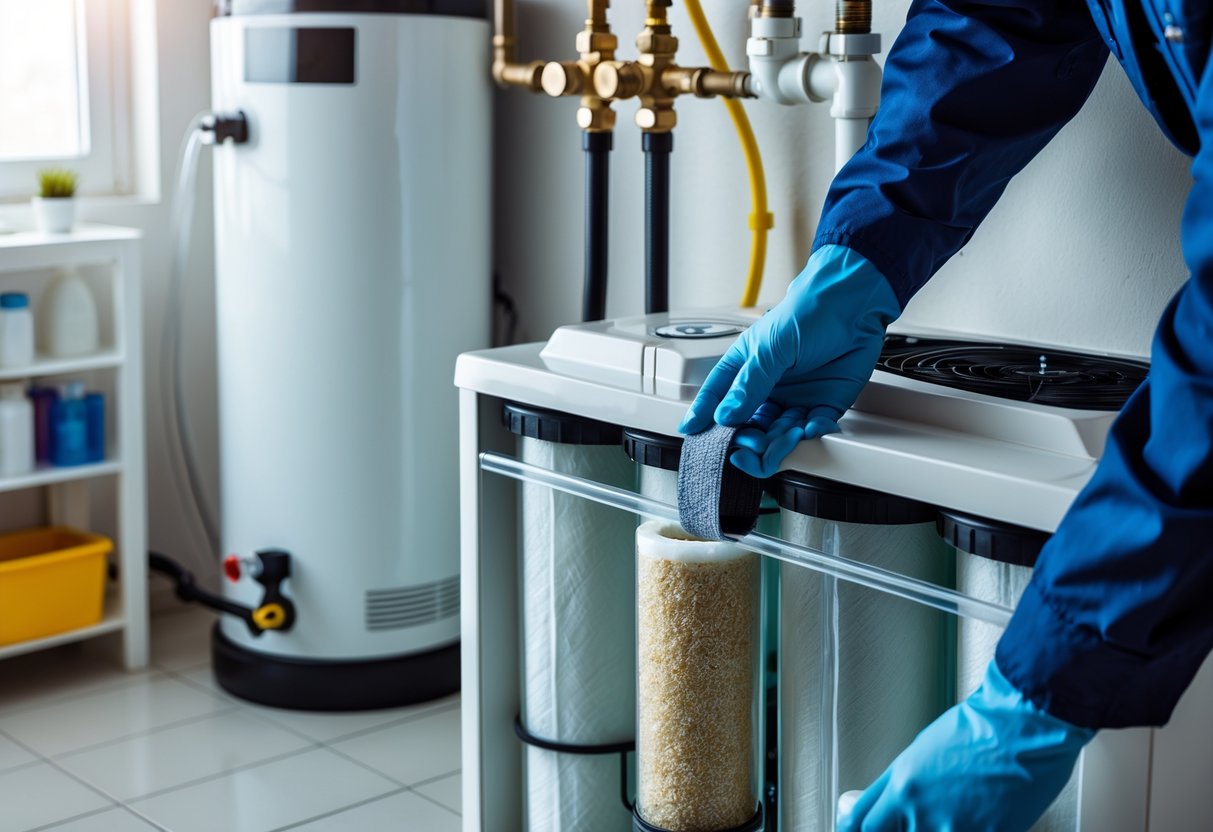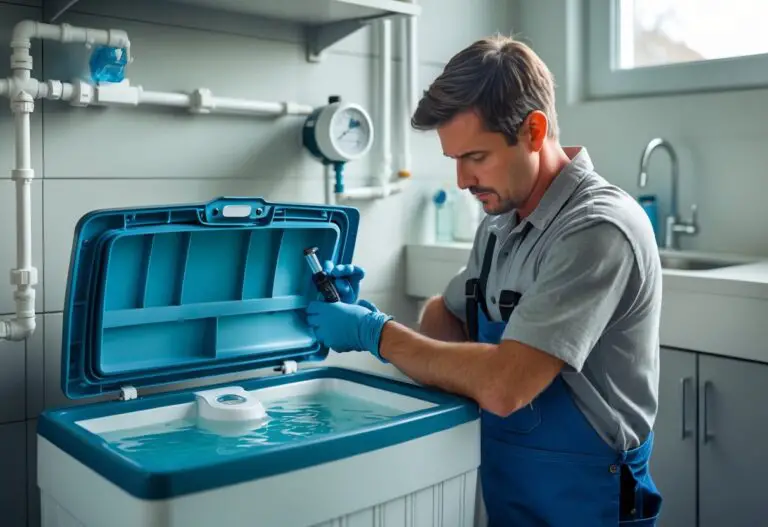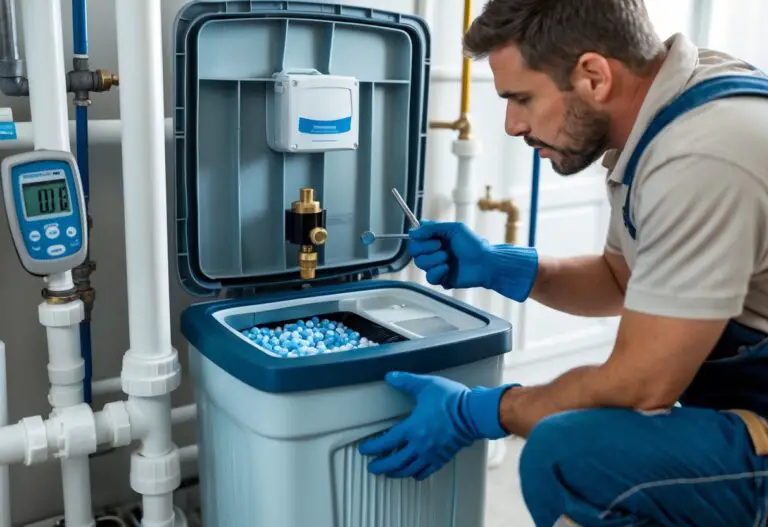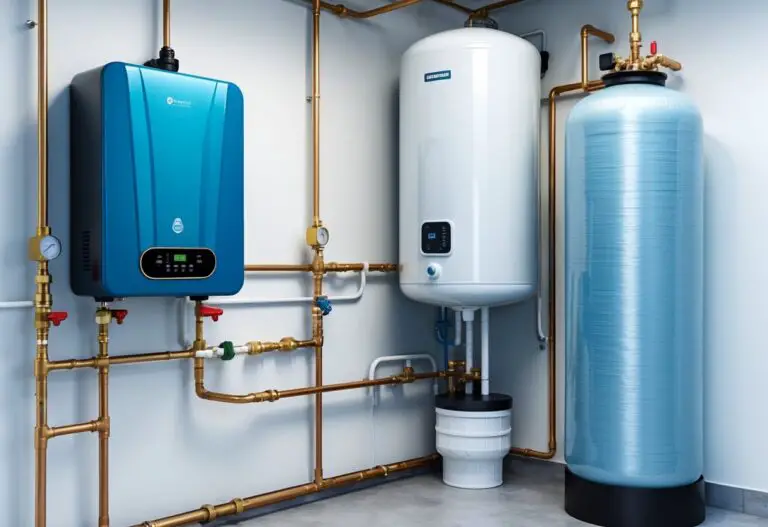When your water softener stops working properly, you might notice soap scum on dishes, mineral buildup on faucets, or water that doesn’t feel right. These signs often point to a common problem that many homeowners face.

A clogged water softener usually happens when salt forms hard masses in the brine tank, blocking water flow and stopping the cleaning process that makes your water soft. The good news is that you can fix most clogs yourself using simple tools you already have at home.
Weather changes and humidity can turn salt pellets into solid bridges at the bottom of your tank. When this happens, your water softener can’t do its job. Understanding how to spot and fix these clogs will save you money and keep your water soft.
Key Takeaways
- Hard water signs like soap spots and mineral buildup often mean your water softener is clogged
- Salt bridges in the brine tank are the most common cause of water softener clogs
- Regular cleaning and maintenance help prevent clogs and keep your system working properly
Recognizing a Clogged Water Softener
A clogged water softener shows clear warning signs that affect your daily water use. You’ll notice changes in water pressure, water quality, and how your system operates during its normal cycles.
Key Warning Signs
Your water softener will give you several clues when it’s clogged. The most obvious sign is when hard water problems come back. You’ll see soap scum building up in your shower and dishes coming out of the dishwasher with white spots.
Physical signs to watch for:
- White, chalky buildup on faucets and fixtures
- Soap that won’t lather properly
- Stiff or dingy laundry after washing
- Spots on glassware and dishes
Your brine tank may overflow or fail to drain properly. You might hear unusual noises during the regeneration cycle that weren’t there before.
Small particles that look like sand might appear in your water. These could be broken resin beads from inside your softener tank.
Impact on Water Pressure and Quality
Low water pressure throughout your home is a common sign of a clogged water softener. The clog blocks normal water flow and reduces pressure at all your faucets and appliances.
Your softened water will gradually return to its hard state. This happens because the clog prevents your system from removing minerals properly.
Water quality changes you’ll notice:
- Increased mineral taste in drinking water
- Film on shower doors and bathtub surfaces
- Reduced effectiveness of soaps and detergents
- Scale buildup in coffee makers and other appliances
The water pressure drop usually happens slowly. You might not notice it right away until it becomes severe.
How to Confirm a Clog
Start by checking your brine tank for salt bridges. These are hard crusts that form on top of the salt pile. Use a broom handle to gently poke the salt surface.
Test your water hardness with test strips. If the results show hard water even though your softener is running, you likely have a clog.
Steps to confirm the problem:
- Check if the brine tank drains completely after regeneration
- Look for salt bridges or mushy salt at the bottom
- Test water hardness at different faucets
- Monitor water pressure at multiple locations
Listen during the regeneration cycle. Missing sounds or unusual noises can indicate blocked valves or lines.
Check for resin beads in your water by filling a clear glass. Let it sit for a few minutes and look for small, round particles at the bottom.
Common Causes of Water Softener Clogs
Water softener clogs typically stem from salt-related problems in the brine tank or mineral deposits throughout the system. Salt bridges and mushing are the most frequent culprits, while limescale buildup and foreign objects can also disrupt proper function.
Salt Bridge Formation
A salt bridge forms when a hard crust of salt develops in your brine tank above the water level. This creates an empty space between the salt and water below.
Salt bridges prevent your system from creating the brine solution needed for regeneration. When this happens, hard water minerals pass through untreated.
Common causes of salt bridging include:
- Using rock salt instead of salt pellets
- High humidity in the installation area
- Temperature changes around the unit
- Overfilling the brine tank with salt
You’ll notice salt bridges when spots appear on dishes and glassware. Your water may feel harder than usual during showers or washing.
The salt appears solid on top but has hollow spaces underneath. Breaking through the surface with a broom handle reveals the gap below.
Salt Mushing and Buildup
Salt mushing occurs when dissolved salt recrystallizes at the bottom of your brine tank. This creates a thick, paste-like layer that blocks water flow.
Unlike salt bridges, mushing happens at the tank bottom. The salt turns into a sludge that won’t dissolve properly during regeneration cycles.
Factors that cause salt mushing:
- Using the wrong type of salt
- Adding salt too frequently in small amounts
- Poor water circulation in the tank
- Old salt sitting too long without use
Mushing reduces your system’s ability to create strong brine. Your water becomes harder over time as the resin bed can’t regenerate effectively.
You might see a thick, muddy substance when you look into your brine tank. The salt level appears normal, but the bottom feels soft or mushy.
Mineral and Limescale Accumulation
Hard water minerals can build up inside your water softener components over time. Calcium and magnesium deposits form on resin beads and internal parts.
Limescale buildup restricts water flow through pipes and valves. This reduces system efficiency and can cause complete blockages in narrow passages.
Areas prone to mineral buildup:
- Resin bed surface
- Control valve components
- Internal water lines
- Injector and venturi parts
Heavy mineral accumulation makes your resin bed less effective. The beads become coated and can’t exchange ions properly.
Your water pressure may drop throughout the house. Regeneration cycles take longer or don’t complete fully.
Regular cleaning helps prevent serious mineral buildup. Using evaporated salt instead of rock salt reduces additional mineral content.
Foreign Object Blockages
Small objects sometimes enter your water softener system and cause clogs. These blockages typically occur in narrow passages or valve components.
Debris can come from your home’s plumbing system or enter during maintenance. Even tiny particles can block critical water flow paths.
Common foreign objects include:
- Pipe sediment and rust flakes
- Broken resin beads
- Gasket pieces or seal fragments
- Small tools dropped during service
Foreign blockages often cause sudden changes in water pressure. Your system may stop working completely rather than gradually declining.
You might hear unusual noises during regeneration cycles. Water flow becomes irregular or stops entirely in some cases.
Professional diagnosis helps locate hard-to-find blockages. Some clogs require disassembly of internal components to remove safely.
Troubleshooting and Fixing a Water Softener Clog
Fixing a clogged water softener requires checking four main areas: the brine tank for salt problems, clearing any salt bridges, cleaning the injector system, and inspecting water lines. Most clogs happen in these spots and can be fixed with basic tools.
Inspecting the Brine Tank
Start by turning off your water softener and switching the bypass valve to stop water flow. Remove the brine tank lid and look inside the salt tank.
Check the water level first. The brine well should have some water, but not too much. If you see standing water covering the salt, your tank might not be draining properly.
Look for these common problems:
- Salt bridges – hard crusts that form above the water
- Salt mush – thick, sludgy salt at the bottom
- Dirty water – brown or cloudy brine water
- Old salt – yellowed or clumped salt pellets
Use a flashlight to check all corners of the brine tank. Push gently on the salt with a broom handle to test if it moves freely.
If the salt feels solid or doesn’t break apart easily, you have a salt bridge problem. This stops the control valve from making proper brine during regeneration cycles.
Clearing Salt Bridges and Mush
Break up salt bridges by pushing down with a long tool like a broom handle or wooden stick. Never use metal tools that might damage the tank.
Start at the edges and work toward the center. The salt bridge will crack and fall into the water below. Remove any large chunks by hand.
For salt mush at the bottom, you need to empty the entire brine tank. Scoop out all the salt and pour out the water.
Steps to clean salt mush:
- Remove all salt from the tank
- Pour out dirty brine water
- Scrub the tank with warm soapy water
- Rinse completely and let dry
- Add fresh salt pellets only
Fill the clean brine tank with high-quality salt pellets. Avoid using rock salt or table salt, which create more problems.
Add water to start the brine-making process. Most tanks need about 3 inches of water in the brine well.
Cleaning the Injector and Nozzle
The injector creates suction to pull brine from the salt tank into the resin tank. When it gets clogged, your softener can’t regenerate properly.
Find the injector assembly on your control valve. It usually has a cap you can unscrew by hand or with pliers.
Remove the injector carefully and check for mineral buildup or debris. The nozzle and throat are very small and clog easily.
Cleaning process:
- Soak parts in warm water for 15 minutes
- Use a soft brush to scrub away buildup
- Run water through each piece
- Check that holes are completely clear
Never use sharp objects to clean the injector. This can damage the precise openings and ruin the part.
If cleaning doesn’t work, you may need to replace the injector assembly. Make sure to get the exact part for your control valve model.
Checking the Brine and Drain Lines
Inspect the small tube that connects your brine tank to the control valve. This brine line carries salt water during regeneration.
Disconnect the line and look inside both ends. Mineral deposits or salt crystals can block the narrow tube completely.
Flush the brine line with warm water to remove loose debris. For stubborn clogs, use a thin wire or compressed air to clear the blockage.
The drain line removes wastewater during regeneration cycles. Check where it connects to your drain or utility sink.
Common drain line problems:
- Kinked or bent tubing
- Mineral buildup at connections
- Debris blocking the drain opening
- Air gaps that are too small
Make sure the drain line has a proper air gap to prevent backflow. The line should not touch the drain water directly.
Run a manual regeneration cycle to test both lines. Watch for proper water flow during each cycle phase.
If problems continue after cleaning, the control valve itself might need professional repair or replacement.
Prevention and Maintenance Tips
Proper maintenance prevents most water softener clogs and keeps your system running smoothly for years. Following a regular care schedule protects your investment and ensures consistent soft water throughout your home.
Proper Salt Usage and Storage
The type and quality of salt you use directly affects your water softener’s performance. High-quality salt pellets work best because they dissolve evenly and leave fewer residues than rock salt or crystal salt.
Store salt in a dry location away from moisture. Humidity causes salt to clump together and form bridges in your brine tank. Keep salt bags sealed until you need them.
Fill your brine tank to the recommended level only. Most tanks should be filled to about two-thirds capacity. Overfilling compacts the salt and creates bridges that block proper dissolving.
Check your salt level monthly. Add new salt when the level drops to about one-quarter full. This prevents your resin bed from becoming exhausted between refills.
Use only salt designed for water softeners. Avoid table salt, rock salt with high impurities, or any salt containing anti-caking agents that can damage your system.
Regular Cleaning Routines
Clean your brine tank every six months to prevent buildup and clogs. Empty the tank completely and scrub the walls with warm soapy water to remove salt residue and debris.
Inspect the brine well monthly for blockages. The small tube inside your brine tank can collect sediment that blocks the flow of brine solution during regeneration cycles.
Break up salt bridges as soon as you spot them. Use a wooden handle or plastic tool to gently break the hardened salt crust. Never use metal tools that might damage the tank.
Wipe down the exterior and control panel regularly. Keep vents clear of dust and debris that can affect the system’s operation and ventilation.
Check all connections and fittings for leaks or corrosion. Tighten loose connections but avoid over-tightening which can damage threads.
Water Pressure Management
Monitor your home’s water pressure regularly. High pressure above 80 PSI can damage internal components and cause premature wear on seals and valves.
Install a pressure regulator if your water pressure exceeds recommended levels. Most water softeners work best with pressure between 20-80 PSI.
Check for pressure drops that might indicate clogs in your system. Low water pressure throughout your home often signals blockages in the resin bed or control valve.
Test your water hardness every few months. Changes in water hardness levels may require adjustments to your regeneration schedule to prevent resin bed exhaustion.
Perform manual regeneration if you notice hard water problems returning. This helps flush accumulated minerals before they cause serious blockages.
When to Seek Professional Help
Call a professional if your water softener stops regenerating completely. Control valve problems require specialized tools and knowledge to repair safely.
Contact an expert when you find hard water problems persist after trying basic maintenance steps. Internal component failures need professional diagnosis and replacement.
Seek help if you notice unusual noises, persistent leaks, or electrical issues with the control panel. These problems can worsen quickly and cause expensive damage.
Schedule annual professional inspections even when your system seems to work fine. Technicians can spot developing problems before they cause complete system failure.





